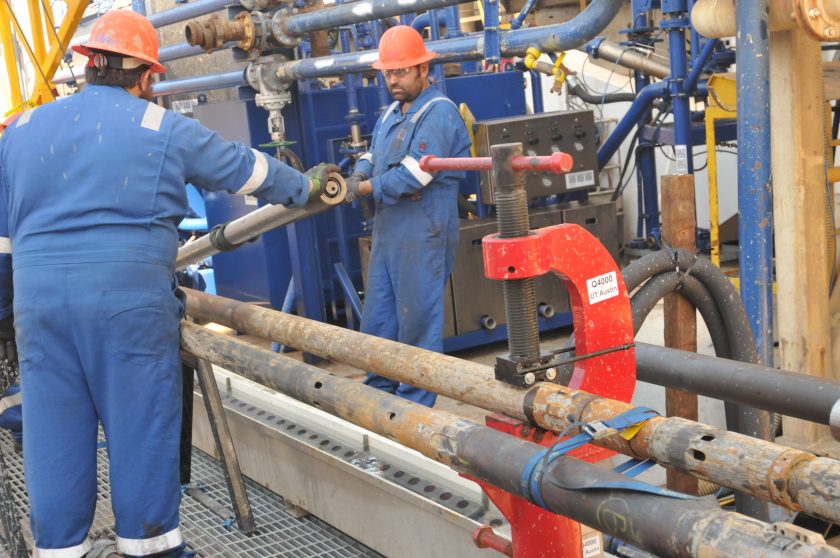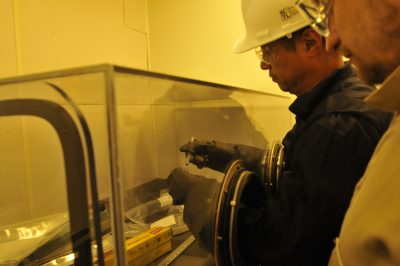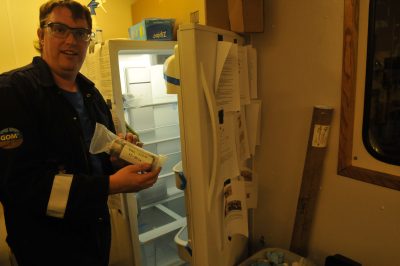Bingo!
May 14, 2017

This is the fourth post in a series on the Jackson School-led mission to drill for samples of methane hydrate from under the Gulf of Mexico for scientific study. Read the third post here.
Gulf of Mexico – The crew on the Helix Q4000 hit pay dirt on the fourth try, pulling up a core under pressure that contained methane hydrate.
The success highlighted what has otherwise been a frustrating go at perfecting the experimental coring technique, and the science team is considering moving locations and switching to the second specialized coring tool they have brought on the mission. Still, the team has been able to perform some of the science they have been preparing for.

One of the challenges of conducting a scientific drilling mission from an industrial rig is assembling the necessary laboratory facilities. The challenge is heightened on this mission because of the innate properties of methane hydrate.
Buried under the Gulf floor, the methane hydrate the team is sampling is under immense pressure – more than 200 times the pressure found on the surface. If that pressure drops significantly at any time the methane hydrate will dissociate, or simply melt away into the atmosphere. The pressure makes the methane hydrate difficult to handle, but it’s also what makes the substance very appealing as a future source of natural gas. Consider, one liter of methane hydrate held pressurized under the Gulf of Mexico contains the equivalent of 160 liters of methane hydrate on the surface.
To deal with the difficulty posed by the pressure, the scientific team and subcontractor Geotek have built a series of laboratories on the rig floor in shipping containers. This includes a specialized shop to assemble, disassemble and repair the coring tool. The tool is basically a roughly 10-foot-long cylinder capable of being lowered some 8,000 feet down the drilling string and capturing a core sample from the subsurface before being pulled back up to the surface. (Check out the scientific team’s blog entry on the tool and the process on The University of Texas Institute for Geophysics site.)
Once the core is successfully brought to the surface, it is quickly scanned for velocity and density measurements and a 2D x-ray image is taken.

There are several other lab facilities aboard. The team has already use the mud lab several times. This is an area where samples are prepared and stored for shipping to various labs throughout the country for analysis. The Jackson School is leading the expedition, but scientists are involved from all over the country. The team aboard the Helix Q4000 also includes researchers from Ohio State University, the U.S. Department of Geological Survey, the U.S. Department of Energy and Columbia University. The geochemistry samples prepared in the mud lab will be shipped to the University of Washington for analysis, and the microbiology samples to ExxonMobil.
One of the more unique aspects of the mud lab is a contraption called a glove box where microbiology samples can be prepared in an all-nitrogen environment so they are not contaminated and altered by oxygen (see picture). The team is not just preparing samples of the core, but is also preparing samples of the fluids being used in the drilling and the specialized pressure equipment and the sea water itself. Contamination from any could alter the science and needs to be accounted for, said Steve Phillips, Jackson School staff scientist.
“For instance there are microbial communities that exist in the surface of the ocean and the sea water that is mixed up in the drill mud that don’t exist 400 meters below the seafloor where samples are drawn,” he said. “It’s all about quality control. Getting good data.”
Anton Caputo, Jackson School Communications Director
